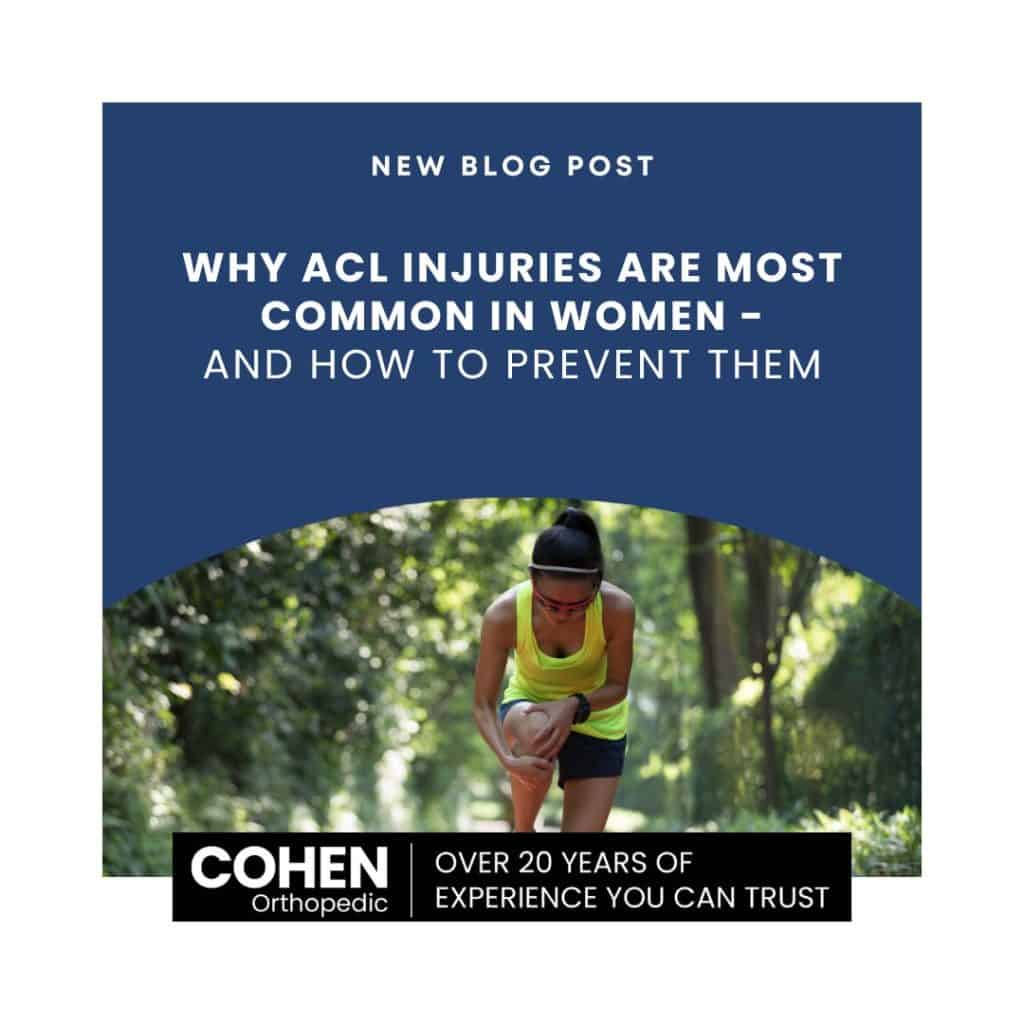Why ACL Injuries are Most Common in Women – and How to Prevent Them

An anterior cruciate ligament (ACL) injury is one of the most common and serious knee injuries, especially for athletes. While both men and women can experience ACL tears, studies have shown that women are more likely to sustain this type of injury. Understanding why ACL injuries are more prevalent in women—and what can be done to prevent them—can help reduce the risk and keep you moving.
Why Are ACL Injuries More Common in Women?
The reasons why women are more prone to ACL injuries are complex and multifactorial, involving a mix of biological, anatomical, and hormonal factors. Here’s a closer look at why women are at greater risk:
1. Anatomical Differences
Women tend to have a wider pelvis than men, which affects the alignment of the lower body. This anatomical difference leads to a greater Q-angle (the angle between the quadriceps muscle and the patella tendon), which can cause more strain on the knee joint. The increased Q-angle places women at higher risk of improper knee alignment during physical activity, making the ACL more susceptible to injury.
2. Hormonal Factors
Estrogen, a hormone that plays a key role in the female reproductive system, can also influence ligament strength. Some studies suggest that hormonal fluctuations, particularly during different phases of the menstrual cycle, may weaken the ACL. Research has shown that during the ovulatory phase (mid-cycle), estrogen levels are higher, and this can impact ligament elasticity and the ability of the ACL to withstand stress.
3. Muscle Strength and Activation Patterns
Women, on average, have less muscle mass than men, particularly in the lower body. This means that women may have less strength in the muscles around the knee, such as the quadriceps and hamstrings, which are essential for stabilizing the joint. Additionally, women often exhibit different movement patterns, such as increased knee valgus (knock knees) during activities like jumping, landing, and cutting, which can place more stress on the ACL.
4. Neuromuscular Control
Neuromuscular control—the coordination between the muscles and nervous system—can also play a role. Studies suggest that women tend to have a different landing technique during activities like jumping or cutting, often landing with straighter knees and less bend in the hip and knee joints. This posture can place more strain on the ACL and increase the likelihood of injury.
How to Prevent ACL Injuries in Women
While women are at a higher risk for ACL injuries, there are several effective strategies to reduce that risk. Prevention often revolves around improving strength, flexibility, and neuromuscular control through specific exercises and training techniques.
1. Focus on Strengthening Key Muscle Groups
Strengthening the muscles surrounding the knee—particularly the quadriceps, hamstrings, and calves—can help reduce stress on the ACL. Focus on exercises that improve both quadriceps-to-hamstring strength ratio and overall lower-body strength, such as:
- Squats and lunges
- Leg presses
- Hamstring curls
- Step-ups
- Single-leg exercises
2. Improve Neuromuscular Control with Plyometric Training
Plyometric training focuses on improving the body’s ability to control explosive movements like jumping, landing, and cutting. Programs that emphasize proper landing mechanics—with a focus on landing with a bent knee and hip—can help reduce the stress placed on the ACL. Common exercises include:
- Jumping drills (e.g., box jumps or squat jumps)
- Landing drills (e.g., teaching soft landings with knees bent)
- Cutting drills (e.g., change of direction training)
3. Balance and Stability Training
Proprioception, or your body’s awareness of its position in space, plays a crucial role in preventing ACL injuries. Exercises that improve balance and stability—such as single-leg stands and exercises on unstable surfaces (e.g., balance boards)—can help develop better control and coordination in the lower body.
4. Stretching and Flexibility
Incorporating stretching routines to improve flexibility in the hips, hamstrings, and calves can help reduce muscle tightness that places extra strain on the knee joint. Regular flexibility exercises can improve the range of motion, which is crucial for maintaining proper knee alignment during sports and physical activity.
5. Consider Biomechanical Screening
For women who participate in sports, working with a trainer or physical therapist to assess their biomechanics (how they move) can help identify movement patterns that may put them at risk. From there, a customized program can be designed to correct improper movement patterns and reduce the likelihood of injury.
Final Thoughts
ACL injuries are a significant concern for many women, particularly those involved in sports. Understanding the reasons behind the increased risk—such as anatomical and hormonal differences—can help women take proactive steps to prevent injury. By focusing on strengthening key muscle groups, improving neuromuscular control, and incorporating flexibility training, women can reduce their risk of ACL tears and continue to enjoy physical activity safely.
If you are at risk for ACL injuries or want to learn more about injury prevention, contact your healthcare provider or physical therapist. A personalized approach to training and injury prevention can help you stay active and strong—without the setback of an ACL injury.
Need support with ACL injury prevention? Dr. Brian Cohen is here to guide you through safe, effective training programs to protect your knees and keep you moving.










